Ijraset Journal For Research in Applied Science and Engineering Technology
- Home / Ijraset
- On This Page
- Abstract
- Introduction
- Conclusion
- References
- Copyright
Formulation and Evaluation of Cinnamon and Walnut Foot Scrub
Authors: Smita Kadam, Rohini Chavan, Surajkumar Chavan, Janhavi Chinchwade
DOI Link: https://doi.org/10.22214/ijraset.2024.64362
Certificate: View Certificate
Abstract
Foot care is a crucial aspect of overall well-being, as our feet endure daily stressors and are often neglected until problems arise. This study focuses on the formulation and evaluation of a cinnamon and walnut foot scrub designed to address common foot issues such as dryness, cracked skin, and fungal infections. Cinnamon is incorporated for its antimicrobial and anti-inflammatory properties, offering a soothing effect while stimulating circulation. Walnut shells serve as an effective natural exfoliant, gently removing dead skin cells and revealing smoother skin underneath. The scrub not only exfoliates but also hydrates, thanks to the nourishing properties of walnut oil, making it particularly beneficial for dry, cracked heels. The prepared formulation was evaluated for various parameters, including color, appearance, consistency, pH, and viscosity. By integrating this scrub into regular foot care routines, individuals can experience improved skin texture and overall foot health. The future of cinnamon walnut foot scrubs looks promising, with potential advancements in formulations tailored to various skin types and conditions, ensuring a natural and effective approach to foot care.
Introduction
I. INTRODUCTION
Foot care is a vital component of overall health, as our feet support our bodies and endure various environmental stressors. Foot scrubs play an essential role in this care, typically incorporating moisturizing ingredients to hydrate the skin after exfoliation.
Cinnamon, renowned for its warm aroma, enhances the sensory experience of the foot scrub while offering potential skin benefits. Its antimicrobial properties aid in cleansing the skin and preventing infections, which is crucial for maintaining foot hygiene. Additionally, cinnamon is believed to have anti-inflammatory effects, providing soothing relief for tired and achy feet.
Walnut shells serve as a natural exfoliating agent, effectively removing dead skin cells to reveal softer skin underneath. The coarse texture of walnut particles helps to slough off rough patches and calluses, improving the overall appearance and feel of the feet. Walnut oil, often combined with the shells, is rich in vitamins and antioxidants that nourish and hydrate the skin, making it particularly effective for addressing dry, cracked heels.
The combination of cinnamon and walnut in a foot scrub offers a comprehensive approach to foot care, delivering exfoliation, moisturization, and potential therapeutic benefits. Incorporating this natural scrub into a regular foot care routine can result in smoother, softer skin and a pampering experience that enhances overall foot health and relaxation.
A. Cinnamon and Walnut in Foot Care
- Cinnamon's Role in Foot Care: Integrating cinnamon into a foot scrub not only adds an inviting scent but also provides potential skin benefits. Known for its antimicrobial properties, cinnamon helps cleanse the skin and prevent infections, a key aspect of foot hygiene. Its anti-inflammatory effects can soothe tired feet, enriching the foot care experience.
- Walnut's Role in Foot Care: Walnut shells are a gentle yet effective natural exfoliant that helps remove dead skin cells, promoting a smoother texture. The coarse texture of ground walnut shells buffs away rough patches and calluses, leading to a refined skin surface. Additionally, walnut oil, extracted from walnuts, is packed with essential fatty acids, vitamins, and antioxidants that deeply hydrate and nourish the skin, making it ideal for treating dry, cracked heels.
B. Comprehensive Foot Care with Cinnamon Walnut Foot Scrub
The fusion of walnut's exfoliating power with cinnamon's aromatic and therapeutic properties results in a foot scrub that provides a holistic approach to foot care. Regular use can enhance circulation, promote skin regeneration, and offer deep hydration, leading to softer, healthier skin. The comforting aroma of cinnamon further elevates the experience, making this scrub a rejuvenating addition to foot health routines.
C. Benefits of Using a Cinnamon Walnut Foot Scrub
- Exfoliation: Walnut particles gently exfoliate the skin, removing dead cells for a smoother texture.
- Moisturization: Walnut oil effectively hydrates the skin, preventing dryness.
- Skin Regeneration: Rich in vitamins E and K, walnuts support skin regeneration and elasticity.
- UV Protection: Walnut oil serves as a natural UV blocker, shielding the skin from sun damage.
- Antioxidant Benefits: Walnuts are rich in antioxidants, protecting the skin from environmental stressors.
- Improved Circulation: Cinnamon promotes better circulation, enhancing foot health and appearance.
- Soothing and Relaxing: The aromatic qualities of cinnamon provide a calming experience during foot care routines.
D. Common Foot Problems
Athlete's foot: A common fungal infection that affects the feet, causing an itchy, stinging, burning rash on the skin, typically between the toes. It can lead to sore, flaky patches, cracked skin, and flu-filled blisters. If left untreated, it can spread to the toenails and cause a fungal nail infection
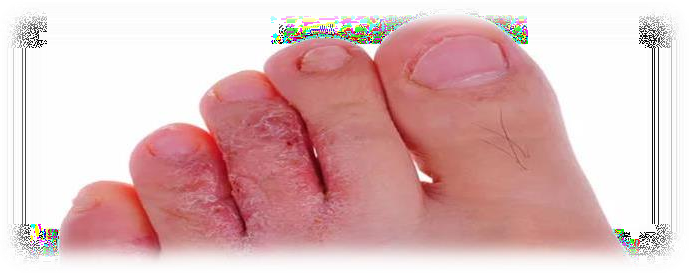
- Dry skin: Refers to skin that lacks moisture, often appearing rough, flaky, and sometimes itchy. Dry skin can be caused by factors like weather conditions, dehydration, harsh soaps, or certain skin conditions.
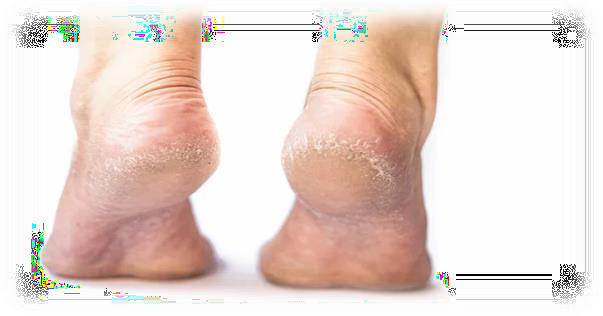
- Dead skin cells: The outer layer of the skin that sheds naturally as new skin cells replace the old ones. Accumulation of dead skin cells can lead to rough, dull skin and can be effectively removed through exfoliation, like with a foot scrub.
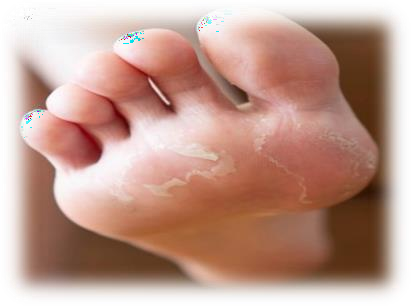
- Cracked heels: Refers to dry, cracked skin on the heels, often caused by factors like dry weather, lack of moisture, prolonged standing, or wearing open-back shoes. Cracked heels can be painful and unsightly
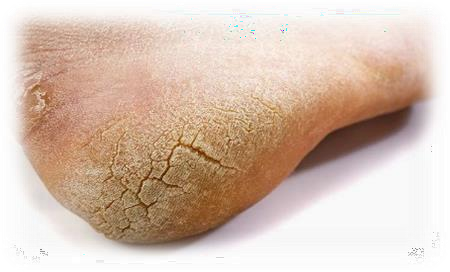
- Foot odor: Unpleasant smell emanating from the feet, usually due to sweat and bacteria interacting on the skin's surface. Foot odor can be exacerbated by factors like poor hygiene, wearing closed shoes for extended periods, or fungal infections like athlete's foot.
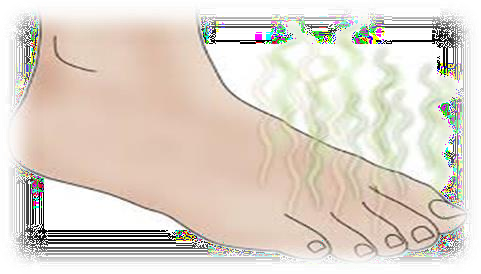
- Rough or damaged foot skin: Skin on the feet that is rough, calloused, or damaged, often due to friction, pressure, lack of moisture, or neglect. Using a foot scrub can help smoothen rough skin and improve its overall condition.
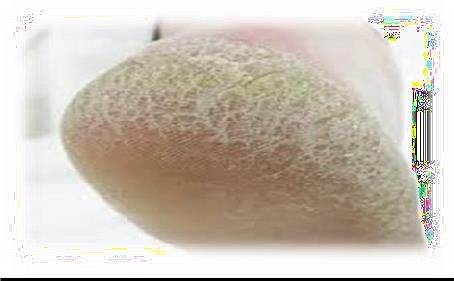
II. METHOD OF PREPARATION
Herbs Used In Foaming Foot Scrub
A. Cinnamon
- Synonyms: Cassia.
- Biological Name : Cinnamomum verum
- Source: Cinnamon comes from the inner bark of multiple tree species, primarily from Cinnamomum verum, which is native to Sri Lanka, India, and Myanmar.
- Family: Lauraceae
- Chemical Constituents: Among the chemical components of cinnamon are cinnamaldehyde, cinnamate, cinnamic acid, and several essential oils, including caryophyllene oxide, eugenol, and L-borneol. Eugenol makes up 5–10% of cinnamon bark oil, but cinnamonaldehyde accounts for 65–80% of the oil.
- Uses:
- Soothing sore feet: Cinnamon can be used in foot soaks to soothe sore feet
- Improving circulation: Cinnamon is a circulatory stimulant that can encourage peripheral blood flow to the hands and feet
- Treating fungal infections: Cinnamon's antimicrobial properties make it effective in treating fungal infections like athlete's foot
- Reducing inflammation: Cinnamon's anti-inflammatory properties can help reduce swelling and inflammation in the feet, beneficial for conditions like plantar fasciitis
- Exfoliating and softening skin: Cinnamon can act as a gentle exfoliant to remove dead skin cells and soften rough areas on the feet
- Deodorizing: Cinnamon's antibacterial properties can help reduce foot odor
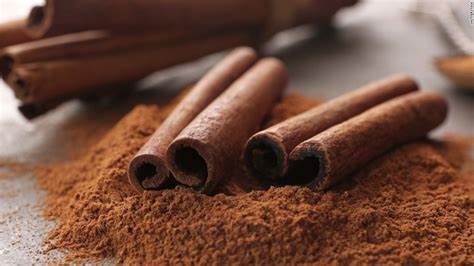
B. Walnut
- Synonyms: Nutwood
- Biological name: Juglans regia.
- Source: Walnut trees are native to the regions stretching from the Balkans to China, but they are also cultivated in many other parts of the world, including the United States, where California is a major producer.
- Family: Juglandaceae.
- Chemical Constituents: The chemical constituents of walnuts include polyunsaturated fatty acids, proteins, and volatile compounds such as pentanal. Additionally, walnuts contain various phytochemical components like gallic acid, catechin, caffeic acid, and tocopherols. The fatty acids found in walnuts include linoleic acid and oleic acid, with linoleic acid being the most abundant. Moreover, walnuts also contain minerals like potassium, calcium, phosphorus, magnesium, sulfur, iron, and zinc, as well as bioactive compounds and phenolic compounds
- Uses:
- Exfoliating Scrubs: Crushed walnut shells are used as a natural exfoliant in foot scrubs to remove dead skin cells and rough patches.
- Foot Soaks: Ground walnut shells are added to foot soak recipes to provide gentle exfoliation and a soothing aroma.
- Massage Tools: Whole or partially crushed walnut shells are used as massage tools to stimulate circulation and relieve tension in the feet.
- Foot Powder: Ground walnut shells may be incorporated into foot powders to absorb moisture and control foot odor.
- Shoe Deodorizers: Dried walnut shells are placed inside shoes to absorb moisture and neutralize odors, keeping footwear fresh.
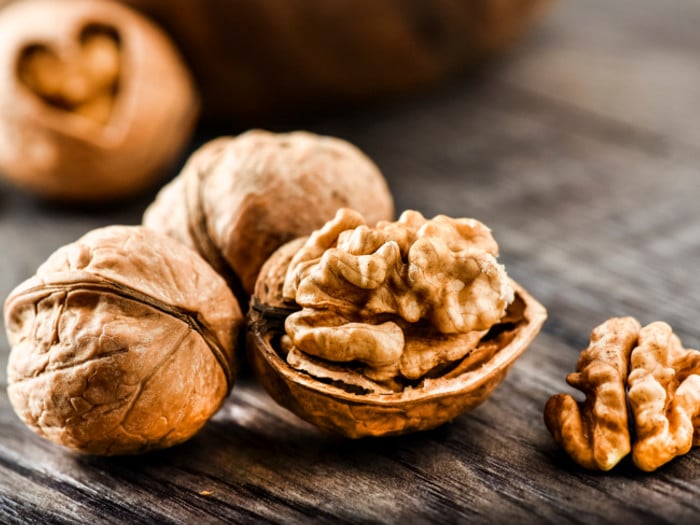
C. Reetha
- Synonym: Soapnut
- Biological Name: Sapindus Mukorossi.
- Source: Reetha, also known as soapnut, which is native to parts of Asia, particularly India and Nepal.
- Family: Sapindaceae
- Chemical Constituents : The chemical constituents of reetha (soapnuts) include Triterpenoid saponins,Fatty acids: Such as oleic acid, linoleic acid, and palmitic acid,Sugars,Polyphenols.
- Uses:
- Cleansing: Reetha foot soaks or washes cleanse feet, removing dirt and impurities.
- Odor Control: Its antimicrobial properties help combat foot odor.
- Exfoliation: Reetha foot scrubs remove dead skin cells, leaving feet smooth.
- Antifungal: It can treat fungal infections like athlete's foot.
- Moisturizing: Reetha moisturizes dry, cracked skin and softens calluses.
- Relaxation: Reetha-infused foot baths or massages soothe tired feet and promote relaxation.
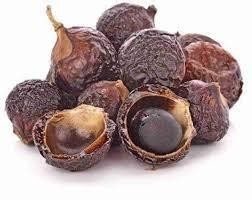
D. Coconut Oil
- Synonyms: Cocos
- Biological name: Cocos nucifera L.
- Source: The source of coconut oil is the coconut palm tree, scientifically known as Cocos nucifera. It is a tropical palm tree species native to regions such as Southeast Asia, South Asia, and the Pacific Islands
- Family: Arecaceae, commonly referred to as the palm family.
- Chemical Constituents: The chemical constituents for coconut oil include, Lauric acid, Myristic acid These two components are naturally occurring in plant and animal fats, with lauric acid and myristic acid being the main components of coconut oil.
- Uses:
- Moisturizes and hydrates dry, cracked feet
- Treats fungal and bacterial infections
- Reduces inflammation and pain
- Improves sleep and reduces stress
- Strengthens and nourishes nails
- Treats plantar warts
- Soothes corns and calluses
- Prevents blisters
- Relieves athlete's foot
- Promotes wound healing
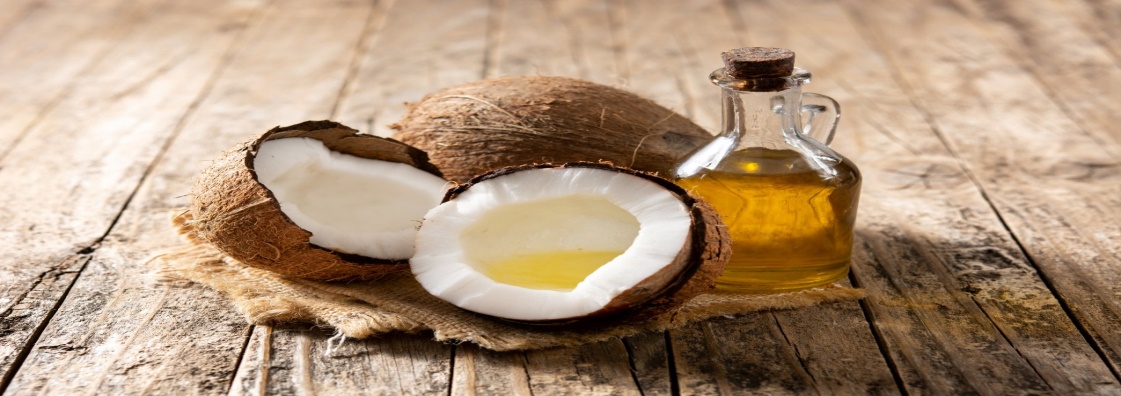
E. Sandalwood
- Synonyms: Chandan
- Biological name: Santalum album.
- Sources: The primary source of sandalwood is the heartwood of the Santalum album tree, also known as the East Indian sandalwood tree
- Family: Santalaceae.
- Chemical Constituents : The chemical constituents of sandalwood include sesquiterpene alcohols such as a-santalol, b-santalol, b-sinensal, and santalol. These compounds are the main constituents found in sandalwood oil, which is derived from sandalwood powder.
- Uses:
- Soothing sore feet: Cinnamon can be used in a foot soak to soothe sore feet.
- Improving circulation: Cinnamon is a circulatory stimulant that can encourage peripheral blood flow to the hands and feet.
- Treating fungal infections: Cinnamon's antimicrobial properties make it effective in treating fungal infections.
- Reducing inflammation: Cinnamon's anti-inflammatory properties can help reduce swelling and inflammation in the feet.
- Exfoliating and softening skin: Cinnamon can be used in a foot scrub to exfoliate and soften rough skin.
- Deodorizing: Cinnamon's antibacterial properties can help reduce foot odor
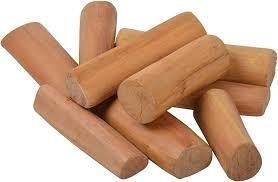
III. FORMULATION TABLE
|
Sr.no |
Ingredients |
Category |
TRIALS |
||
|
F1 |
F2 |
F3 |
|||
|
1. |
Water |
Solvent |
71gm |
68gm |
66gm |
|
2. |
Cetyl alcohol |
Emulsifier and thickner |
5gm |
5gm |
5gm |
|
3. |
Cetosteryl alcohol |
Emulsifier and thickner |
2gm |
2gm |
2gm |
|
4. |
Steric acid |
Emulsifier and thickner |
2gm |
3gm |
3gm |
|
5. |
Sodium benzoate |
Preservative |
1gm |
1gm |
1gm |
|
6. |
Coconut oil |
Emollient |
6ml |
8ml |
8ml |
|
7. |
Cinnamon powder |
Exfoliating agent |
2gm |
2gm |
2gm |
|
8. |
Sandalwood powder |
Reduces tan |
1gm |
1gm |
1gm |
|
9. |
Walnut powder |
Exfoliator and promotes smoother complexion |
5gm |
5gm |
5gm |
|
10. |
Reetha |
Foaming agent |
5gm |
5gm |
7gm |
A. Method of Preparation of Cinnamon Walnut Foot Scrub (F1 to F3)
- Sieving: As the powdered ingredients contained some granules they were sieved with sieve number 60/80 and the fine powders were weighed.
- Weighing: All the ingredients were weighed according to quantity needed .
- Heating:
- Oil phase Ingredients (Cetyl alcohol,Cetosteryl alcohol, Stearic Acid,and coconut oil ) were melted in a beaker in a water bathat 70°-80°C.
- Water phase: The water phase ingredients (distilled water ) heated to 70°-80°C. sodium benzoate was dissolved in 40 % water phase . And in remaining quantity of water Reetha was dssolved.
- Homogenising: Melted oil phase was added to heated water phase along with dissolved Reetha water and homogenise for few minutes while continuous stirring until it turns creamy consistency..
- Cool down phase: Once The base was cool down sifted powdered herbal ingredients were added and homogenised the mixture further.
- Packaging: Finally the Creamy Scrub was poured into a suitable container and labelled.
IV. EVALUATION TEST FOR CINNAMON WALNUT FOOT SCRUB
A. Organoleptic Evaluation
|
PARAMETER |
RESULTS |
|
Colour |
Brown |
|
Odour |
Characteristic |
|
Texture |
Creamy with walnut and cinnamon powder granules |
|
Appearance |
Creamy Scrub |
B. Physicochemical Evaluations
1) pH test: pH of the prepared scrub was evaluated. In pH meter the pH of formulation was found to be 5.22.

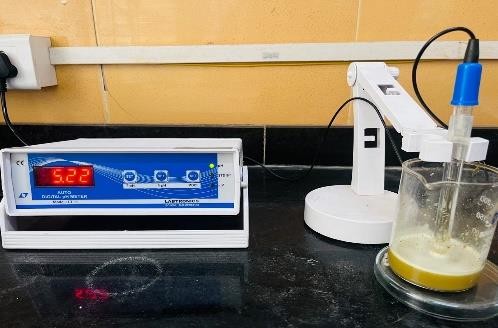
2) Viscocity: A Brookfield Viscometer was used to measure viscosity with spindle number S-64. 50ml of foot scrub was poured in the beaker and the viscosity was evaluated at 20 rpm and was found to be cP 9420
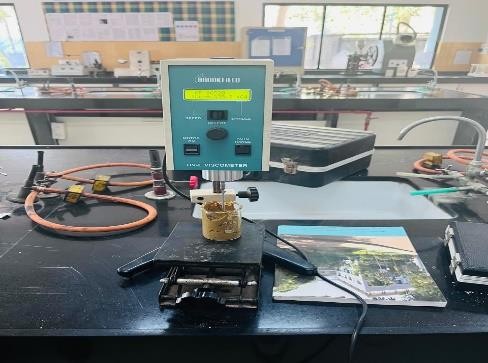
Brookfield viscometer
3) Foaming Test: The foaming test of the foot scrub was performed by vigourously agitating test tube containing 10 gm of sample in 100ml of water and it took 15 secs to form froth.

4) Irritability Test: A small amount of formulation was applied on the skin and kept for 30 minutes and found to be non-irritated
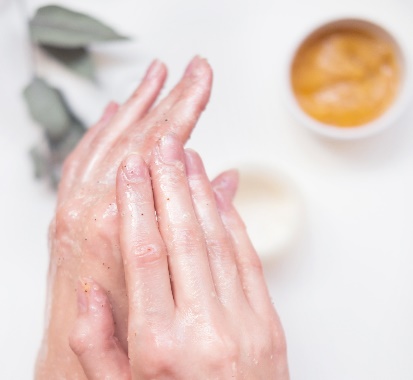
Irritability Test
V. RESULTS
Evaluation parameter of cinnamon walnut foot scrub
|
PARAMETER |
RESULTS |
|
Physical appearance |
Dark brown colour |
|
pH |
5.22 |
|
Viscocity [cp] |
At 20 rpm 9420 cp |
|
Spreadability |
Easily spreadable |
|
irritability |
Not irritable |
VI. SUMMARY
Herbal Foaming Foot Scrub play a pivotal role in nurturing and maintaining healthy feet by harnessing cleansing,exfoliating and conditioning properties.They serve as a compelling alternative for addressing various foot care needs, offering a natural, non-toxic, and beneficial solution with each application
Conclusion
In conclusion, the use of a cinnamon walnut foot scrub can effectively maintain healthy and rejuvenated feet. It offers antimicrobial and anti-inflammatory properties, gentle exfoliation, and hydration, addressing common foot problems while promoting relaxation and overall foot health.
References
[1] R. Baran and H. I. Maibach, Textbook of Cosmetic Dermatology, 2nd ed. London: Martindunitz, 1998, pp. 121–128. [2] J. S. Cannell, \"Fundamentals of Stability Testing,\" Int. J. Cosmetic Sci., vol. 7, pp. 291–303, 1985. [3] Government of India, \"Indian Standard Specification of Skin Creams IS: 6608:2004,\" Bureau of Indian Standards, Ministry of Consumer Affairs, Food and Public Distribution, Manak Bhavan, New Delhi, India, 2004, pp. 1–7. [4] N. Packianathan and R. Kandasamy, \"Skin Care with Herbal Exfoliants,\" Functional Plant Sci. Biotechnol., vol. 5, no. 1, pp. 94–97, 2011. [5] S. D. Seth and B. Sharma, \"Medicinal Plants in India,\" Indian J. Med. Res., vol. 120, pp. 9–11, 2004. [6] P. K. Mukherjee, Quality Control of Herbal Drugs: An Approach to Evaluation of Botanicals, 1st ed. Business Horizon Pharmaceutical Publication, 2002, pp. 708, 709, 791, 742, 3, 4, 5, 7. [7] Y. K. Palav and M. Priscilla, \"Standardization of Selected Indian Medicinal Herbal Raw Materials Containing Polyphenols as Major Phytoconstituents,\" Indian J. Pharm. Sci., vol. 68, no. 4, pp. 506–509, 2006. [8] S. S. Agrawal and M. Paridhavi, Herbal Drug Technology. Hyderabad: Universities Press (India) Pvt. Ltd., 2007, p. 225. [9] World Health Organization, \"Quality Control Methods for Medicinal Plant Materials,\" Geneva: AITBS Publisher and Distributors, 2002, pp. 8–70. [10] H. Damayanti, A. Aprilliani, and C. D. Nancy, \"Formulation of Body Scrub Cream from Extract of Arabika Green Coffee (Coffea arabica L.) as Antioxidant,\" Advances in Health Sciences Research, vol. 33. [11] Parashar, P. Sharma, A. Kabra, and P. Sharma, \"Formulation and Evaluation of Polyherbal Face Cream,\" Int. Pharm. Sci., vol. 3, no. 3, pp. [insert page range here], Jul.–Sep. 2013. [12] \"Sandalwood Album Oil as a Botanical Therapeutic in Dermatology,\" J. Clin. Aesthet. Dermatol., US National Library of Medicine, National Institutes of Health. [Online]. Available: https://www.ncbi.nlm.nih.gov/pmc/articles/pmc5749697/ [13] R. Bhattacharjee and V. Keshavamurthy, \"Re-discovering Sandalwood: Beyond Beauty and Fragrance,\" Indian Dermatol. Online J., vol. 10, no. 3, pp. 296–297, May–Jun. 2019. [Online]. Available: https://www.ncbi.nlm.nih.gov/pmc/articles/PMC653605 [14] T. F. Yeh, C. Y. Lin, and S. T. Chang, \"A Potential Low-Coumarin Cinnamon Substitute: Cinnamomum osmophloeum Leaves,\" J. Agric. Food Chem., vol. 62, pp. 1706–1712, 2014. [PubMed] [Google Scholar] [15] R. O. Wijesekera, \"Historical Overview of the Cinnamon Industry,\" CRC Crit. Rev. Food Sci. Nutr., vol. 10, pp. 1–30, 1978. [PubMed] [Google Scholar] [16] Juicy Chemistry. (n.d.). Peppermint oil for skin: Benefits and how to use. Retrieved from https://juicychemistry.com/blogs/skincare-blog/peppermint-oil-for-skin-benefits-and-how-to-use [17] Medical News Today. (2023, July 10). Vitamin E: Benefits and sources. Retrieved from https://www.medicalnewstoday.com/articles/vitamin-e [18] Healthline. (2022, February 25). Glycerin for skin whitening: Benefits and how to use. Retrieved from https://www.healthline.com/health/glycerin-for-skin-whitenin
Copyright
Copyright © 2024 Smita Kadam, Rohini Chavan, Surajkumar Chavan, Janhavi Chinchwade . This is an open access article distributed under the Creative Commons Attribution License, which permits unrestricted use, distribution, and reproduction in any medium, provided the original work is properly cited.

Download Paper
Paper Id : IJRASET64362
Publish Date : 2024-09-27
ISSN : 2321-9653
Publisher Name : IJRASET
DOI Link : Click Here
 Submit Paper Online
Submit Paper Online

